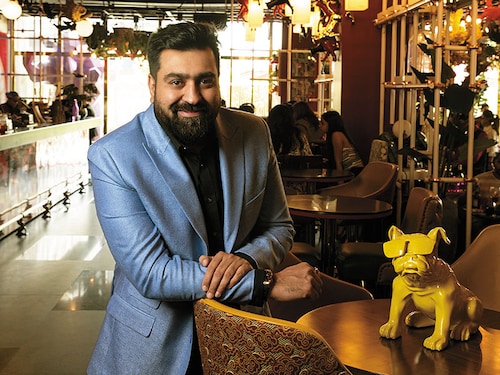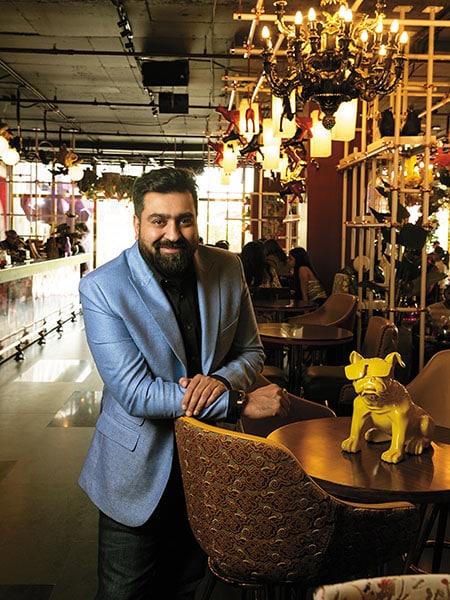You have to keep reinventing the wheel: F&B entrepreneur Priyank Sukhija
F&B entrepreneur Priyank Sukhija, who owns premier hangouts like Lord Of The Drinks, Tamasha and JLWA, talks about what it takes to survive in the industry for 20 years


 Priyank Sukhija, proprietor of brands like Lord of the Drinks, JLWA and Plum By Bent Chair, says that India will soon see a lifestyle shift where people will eat out almost every day
Priyank Sukhija, proprietor of brands like Lord of the Drinks, JLWA and Plum By Bent Chair, says that India will soon see a lifestyle shift where people will eat out almost every day
Image: Madhu Kapparathp[br]Priyank Sukhija was born into a family of lawyers and, if not for his dyslexia, would have probably ended up as one. “Being a lawyer with a reading disability would have been a terrible idea,” says the 39-year-old, who invested in a bowling alley in 1997 instead. But it was canned even before its opening as the government banned operations out of basements following the fire tragedy at the Uphaar cinema hall in Delhi.
At 19, with capital from his father, he set up a restaurant (Lazeez Affaire in New Delhi’s Malcha Marg) to foster his entrepreneurial zeal. Twenty years on, Lazeez Affaire is thriving in an industry that sees fast churn, and Sukhija’s portfolio at the `234-crore First Fiddle Pvt Ltd has expanded to 11 brands (including Lord of the Drinks, Tamasha and Plum By Bent Chair) with 30 outlets across four cities.
Among the most prolific restaurateurs in the country, Sukhija talks to Forbes India about his expansion plans and takeaways from spending two decades in the industry. Edited excerpts:
Q How have you seen the F&B industry change over 20 years?
The size has expanded, but even now we’ve only seen the tip of the iceberg. If 1 percent of Delhi decides to come out once a week, we don’t have enough restaurants to cater to them. Plus, people look at F&B spends as not an expense but a lifestyle matter. Do you know the price of your favourite item at your favourite restaurant? No, because when people eat something they like, they are willing to pay for it. Unlike buying a car or a house, they don’t have to think twice. Our grandparents never went out, our parents took us out once in a month, we go out about once a week and our kids will probably go out every day. Singapore is now selling apartments without kitchens, so you get to eat out every day. That shift will come to India too.
Q With mushrooming restaurants, how does one build customer loyalty?
You have to reinvent the wheel all the time. If you have a product and you sit back because it’s making money, that’s not going to last forever. The customer is so smart today, and the kind of restaurants that used to make money five to eight years ago were very different from what they are now. For instance, 10 years ago, when I would do bars, we used to sell a lot of straight drinks—vodka, whisky, beer etc. Now, you have to be on top of your wines and cocktails. At a place like Plum, 25 percent of my liquor sales come from cocktails and wines. And looking into the future, I feel the number would go up to 60 to 70 percent. Also, earlier, cocktails for us meant a Bloody Mary or Cosmopolitan. But now every place needs to have a signature cocktail that needs to change every season.
Q Making money is tough in the F&B sector now, with a lot of restaurants running into losses and shutting down. How doyou think the industry can turn around?
It’s not that the restaurants aren’t making money. We closed the last fiscal at `234 crore, a 30 percent increase from the previous fiscal, which we ended at `182 crore. Lord Of The Drinks and Tamasha in Mumbai have paid us back in the first year itself. Plum in Delhi’s Aerocity gave us our money back in four months it’s been the most successful in terms of return on investment. Having said that, we’ve also had some failures. You’ve got to realise that even after many restaurants, you’ll do a few bad ones better to identify why something went wrong.
We started Openhouse in Connaught Place and in the first three months we realised we went wrong by offering a premium menu. When we tweaked prices and changed some cocktails, it became a success for three years. In Gurugram, we shut down a restaurant in less than a year because we made a bad location choice. Location is key to a restaurant. For instance, I don’t have a single restaurant in a mall. Malls have a finite life, after which the clientele depletes some other mall in the vicinity overtakes it.
Q You have 11 brands in your portfolio now. How have you planned your expansion around them?
We ended up having a lot of brands because we identified Connaught Place as a market and we had eight or nine restaurants there, located within walking distance from each other. Looking ahead, I’d like to seriously go forward with four existing brands, like Lord Of The Drinks, and three new ones. But having a number of brands also lets me move seamlessly from one brand to another. Today, if Warehouse Cafe stops working, I can always convert it into Plum and give it a fresh lease of life for another five years. It also gives me the flexibility to offer different format restaurants to different age groups.
I am really scared to enter the fine-dining space right now. They have high overhead costs. For that, I need to achieve 30 to 40 percent of my sales from alcohol. On a night out, I can spend `5,000 on drinks, but I can’t eat for more than half of that. Earlier, I was only doing bars, where about 70 to 80 percent of our sales would be from liquor. But you don’t build loyalties with straight alcohol, you build it with food. It’s important to ensure at least 50 percent of your sales come from food. So, we are creating hybrid formats that run for lunches as restaurants, as coffee shops in the evening and high-energy bars in the evening.
Q Given that millennials and post-millennials will bring in most of the revenue in future, what are their favourites?
Japanese and pan-Asian food. In 2006, we had done a sushi restaurant that had fallen flat on its face. Now, not only do we have to do sushi, but we have to stand out. For that, we have suppliers who give us better ingredients, we get our tuna from Japan every four days. Italian and Indian food are going down a little because people are becoming more health-conscious. So, kebabs are doing well but curries not so much. I also see a lot of fusion food coming up.
First Published: Jun 08, 2019, 09:55
Subscribe Now